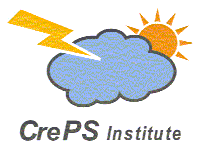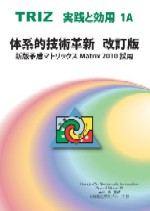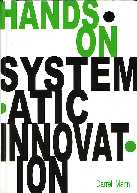 TRIZ Books Publication Announcements: TRIZ Books Publication Announcements: |
  

|
Publication Announcement of the Revised Japanese Edition:
Darrell Mann's "Hands-On Systematic Innovation with Matrix 2010"
by CrePS Institute in the "TRIZ Practices and Benefits" series, Vol. (1A) |
| Toru Nakagawa (Professor Emeritus of Osaka Gakuin University, and Director of CrePS Institute) |
[Note: (1A+)(2A+) Additional 5 sets of Matrix 2010 Sheets (A2 size) (Nov. 13, 2015)] (Nov. 13, 2015)] |
| Posted: Feb. 16, 2014; Updated: Mar. 10, 2014; Nov. 13, 2015 |
For going back to Japanese pages, press

buttons.
 Editor's Note and Publication Announcement (Toru Nakagawa, Feb. 13, 2014)
Editor's Note and Publication Announcement (Toru Nakagawa, Feb. 13, 2014)
The book series "TRIZ Practices and Benefits" in Japanese has been restarted in publication by 'CrePS Institute' as the publisher. (See 
 )
)
The original Vol. 1 was our Japanese edition of Darrell Mann's excellent textbook "Hands-On Systematic Innovation" (HOSI) 
 . It is now replaced with the revised version Vol. 1A "HOSI with Matrix 2010" in short. Using the latest Matrix in the textbook HOSI is quite natural for the author and for us readers. Thus, under the author's approval, I have revised the text at the minumum level while including Matrix 2010 in its full extent.
. It is now replaced with the revised version Vol. 1A "HOSI with Matrix 2010" in short. Using the latest Matrix in the textbook HOSI is quite natural for the author and for us readers. Thus, under the author's approval, I have revised the text at the minumum level while including Matrix 2010 in its full extent.
The books will be availabe in the form of digital downloading [and Print on Demand] from an internet site 'DLmarket' in Japan. (Printing and binding the books need to be done, if necessary, by the customers. I am looking forward the DL market site starting the print & bind & delivery option as the customers' choice, in near future.) ==>
The DLmarket site announced on Feb. 20 that they have started the Print on Demand service. Thus I have started publishing the book series in the style of digital downloading and/or Print on Demand at the DLmarket site. Readers can buy either digital PDF files or printed books or both. (Mar. 10, 2014)
Your readership, suggestions, recommendations, etc. are highly appreciated. Thanks so much for your support.
Note: The second volume "(2A) Matrix 2010" is now published in Japanese Edition  . (Apr. 17, 2014)
. (Apr. 17, 2014)
 Publication Outline
Publication Outline
Original English Edition:
"Hands-On Systematic Innovation"
by Darrell Mann, CREAX Press, Belgium, May 2002.
Revised Japanese Edition:
Title: "TRIZ Practices and Benefits. Vol. 1A.
Systematic Technological Innovation:
with Updated Contradiction Matrix 2010" |

Click to enlarge

|
Supervising Translator: Toru Nakagawa (Osaka Gakuin Univ.)
Translators: Knowledge Creation Study Group (16 members;
at the time of the first Japanese edition)
Masatoshi Hotta, Mikio Fukumura, Hiroshi Ueda, Mitsuo Morihisa,
Hiroaki Kawashima, and Nobuyuki Togashi (SKI),
Yuji Mihara and Hideaki Kosha (Fuji Photo Film Co.),
Shigeru Kasuya, Yoshiya Imoto, Katsumi Sakamaki,
and Akihiko Noda (Fuji Xerox Co.),
Hisao Yasuda, Toshio Kawakubo, Kunitoshi Sugiyama,
and Kazuo Gotoh (Ricoh Co.)
Publisher: CrePS Institute, Kashiwa, Chiba, Japan
Date of publication: February 16, 2014 |
Publishing style: Degital downloading
Site: DLmarket
Site URL: https://www.dlmarket.jp/
CrePS Institute's page in the DLmarket site:
https://www.dlmarket.jp/manufacture/index.php?consignors_id=10832  |
Purchase: Purchase procedure:  , Copyrights handling: , Copyrights handling: |
Notes: Detailed information of the first Japanese Edition of HOSI (2004).   (Jun. 30, 2004) (Jun. 30, 2004)
Detailed information of the revised Japanese Edition of HOSI with Matrix 2010 (2014). See below and the Japanese page  (Feb. 16, 2014). (Feb. 16, 2014). |
Styles of publication and prices, etc. (outline) [See the parent page  .]
.]
| |
Printed book |
Digital files |
Both |
| Style |
Soft cover, B5 size, 502 pages |
zip compressed 4 PDF files, 21.8 MB |
Both of the book and PDF files |
| ISBN |
ISBN978-4-907861-01-8 |
ISBN978-4-907861-00-1 |
Both |
| Price |
7,000 Yen + tax |
5,000 Yen + tax |
10,000 Yen + tax |
| Additional service to the customers |
To the customers of either product listed above, two A2-size printed sheets will be sent on request without charge:
(1) Matrix 2010, (2a) List of parameters, and (2b) List of Inventive Principles.
Please send you request to Nakagawa via email with the information of your purcahse date, shipping address, and your full name. |
 Note: Detailed information (in English) on the earlier edition of HOSI ==>
Note: Detailed information (in English) on the earlier edition of HOSI ==> 
 (Jun. 30, 2004)
(Jun. 30, 2004)
Brief Introduction to the Japanese Edition (Toru Nakagawa, Jun. 30, 2004)
Author's Preface to the Japanese Edition (Darrell Mann, Jan. 200)
Supervising Translator's Preface (Toru Nakagawa, May 2004)
Q&A Documents
(Part 1) Errata and Q&A (Chater 1-11) [PDF 116 KB] (T. Nakagawa, Aug. 2003 + D. Mann Nov. 2003)
(Part 2) Errata and Q&A (Chapter 12-22) [PDF 159 KB] (T. Nakagawa, Oct. 2003 + D. Mann Nov. 2003)
(Part 3) Hierarchical structuring of section headers/ Table of Contents [PDF 101 KB] (T. Nakagawa, Jan. 2004)
(Part 4) Translation Notes [PDF 61 KB] (T. Nakagawa, Jun. 2004)
Table of Contents [PDF 45 KB] (Constructed in detail with some new section headers)
Index (Constructed in detail in Japanese. To be posted later in English. Meantime please see the Japanese page. [PDF 462 KB] )
 Note: Information on Revisions for "HOSI with Matrix 2010"
Note: Information on Revisions for "HOSI with Matrix 2010"
==> See Japanese page in detail 
a. Author's Preface to the Revised Japanese Edition (Darrell Mann, Jan. 27, 2014)
b. Supervising Translator's Preface to the Revised Japanese Edition (Toru Nakagawa, February 4, 2014)
c. Table of Contents (in a simplified form)
d. Excerpts of "Notes for the Revised Japanese Edition" (Toru Nakagawa)
in relation to Chapter 10. Technical Contradiction and Contradiction Matrix 2010
e. Table A2. Meanings of Parameters of Matrix 2010 (part)
f. Table A3. Table of Inventive Principles to be considered for improving each parameter (Matrix 2010) (part)
 Author's Preface to the Revised Japanese Edition (Darrell Mann, Jan. 27, 2014)
Author's Preface to the Revised Japanese Edition (Darrell Mann, Jan. 27, 2014)
It is with a great sense of happiness that I find myself writing this foreword to a new Japanese edition of the technical version of the Hands-On Systematic Innovation book. Of all the book projects I've had the pleasure to be involved in, HOSI has been the one that has been translated most broadly and generated the greatest amount of research-provoking feedback from readers.
One of the main themes of all of the Systematic Innovation research has been the desire to constantly seek to move the subject forward. While many of the original Soviet researchers have claimed that TRIZ is 'complete' and 'shouldn't be touched', my team has taken to heart the words of one of music's greatest innovators, Miles Davis, who once famously said, 'You should never be comfortable, man. Being comfortable fouled up a lot of musicians'.
It would have been very easy, for example, to simply go on re-printing the original 1970s Contradiction Matrix. But when we knew how incredibly inaccurate it had become, we decided we had to bite the bullet and commission what has since turned into a continually resource-hungry programme of dedicated research to update and maintain a Matrix that best serves the evolving needs of problem solvers. It is especially pleasing that we have been able to include the latest version of the Matrix in this edition of the book.
That the Matrix is actually the one first published in 2010 should be taken as a significant indication that the world of technical problem solving has evolved little in the subsequent years. The 2010 Matrix is as accurate in 2014 as it was in 2010.
The main reason for this apparent stagnation, we think, is that the focus of innovation activities within the large majorities of the world's enterprises has made a significant shift in recent times. Thanks in no small part to TRIZ, the world of technical problem solving has become a highly repeatable process. The job of solving marketing and organisational capability problems, on the other hand, is still largely seen as chaotic and uncontrollable, and far closer to trial-and-error 'art' than any kind of science.
Much of the focus of our research activity over the course of the last ten years has thus shifted to these areas. Our rationale for this switch is, I believe, the right one: the technical solving part of the innovation process is so far ahead of the marketing and execution elements that until such times as those two areas 'catch-up', there will be a large population of technical problem solvers who will see their projects fail. Not because they did their work incorrectly, but because they'd either been given the wrong problem to solve by the marketing team, or because the organisation was incapable of executing the new solutions they had created.
Our TrenDNA and ICMM offerings are intended to help organisations resolve these problems, but, based on current estimates, it feels like the world is going to need another 5 to 10 years before the other disciplines have caught up to the point where engineers and scientists will be able to move forward at full speed again.
In the meantime, the technical community in Japan can rest easy at night knowing that they have the safe hands of Professor Toru Nakagawa looking after their interests. When future generations of engineers and scientists look back at the evolution of TRIZ and its successors, I believe that Professor Nakagawa's name will be one of the first ones they look to. No-one in the TRIZ world it seems to me has contributed so much time and energy to the subject and delivered such a complete and coherent record of the evolution of that subject. I sincerely hope that one day his contributions and achievements will be given the recognition they deserve. If I have an opportunity to start that process, I would like to say my own personal thank-you. All power to you, Toru, this one is for you.
Last updated on Mar. 10, 2014. Access point: Editor: nakagawa@ogu.ac.jp

(Nov. 13, 2015)]

